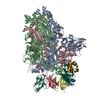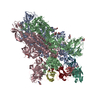+Search query
-Structure paper
| Title | Antigenic structure of the human coronavirus OC43 spike reveals exposed and occluded neutralizing epitopes. |
|---|---|
| Journal, issue, pages | Nat Commun, Vol. 13, Issue 1, Page 2921, Year 2022 |
| Publish date | May 25, 2022 |
 Authors Authors | Chunyan Wang / Emma L Hesketh / Tatiana M Shamorkina / Wentao Li / Peter J Franken / Dubravka Drabek / Rien van Haperen / Sarah Townend / Frank J M van Kuppeveld / Frank Grosveld / Neil A Ranson / Joost Snijder / Raoul J de Groot / Daniel L Hurdiss / Berend-Jan Bosch /    |
| PubMed Abstract | Human coronavirus OC43 is a globally circulating common cold virus sustained by recurrent reinfections. How it persists in the population and defies existing herd immunity is unknown. Here we focus ...Human coronavirus OC43 is a globally circulating common cold virus sustained by recurrent reinfections. How it persists in the population and defies existing herd immunity is unknown. Here we focus on viral glycoprotein S, the target for neutralizing antibodies, and provide an in-depth analysis of its antigenic structure. Neutralizing antibodies are directed to the sialoglycan-receptor binding site in S1 domain, but, remarkably, also to S1. The latter block infection yet do not prevent sialoglycan binding. While two distinct neutralizing S1 epitopes are readily accessible in the prefusion S trimer, other sites are occluded such that their accessibility must be subject to conformational changes in S during cell-entry. While non-neutralizing antibodies were broadly reactive against a collection of natural OC43 variants, neutralizing antibodies generally displayed restricted binding breadth. Our data provide a structure-based understanding of protective immunity and adaptive evolution for this endemic coronavirus which emerged in humans long before SARS-CoV-2. |
 External links External links |  Nat Commun / Nat Commun /  PubMed:35614127 / PubMed:35614127 /  PubMed Central PubMed Central |
| Methods | EM (single particle) |
| Resolution | 3.7 - 4.4 Å |
| Structure data | EMDB-13549, PDB-7pnm: EMDB-13550, PDB-7pnq: EMDB-13563, PDB-7po5:  EMDB-13564: Human coronavirus OC43 spike glycoprotein ectodomain in complex with the 37F1 antibody Fab fragment |
| Chemicals |  ChemComp-NAG: |
| Source |
|
 Keywords Keywords |  VIRAL PROTEIN / VIRAL PROTEIN /  Coronavirus / Coronavirus /  Glycoprotein / Glycoprotein /  Antibody / Spike Antibody / Spike |
 Movie
Movie Controller
Controller Structure viewers
Structure viewers About Yorodumi Papers
About Yorodumi Papers











